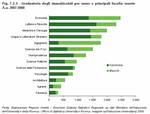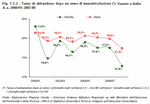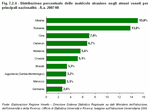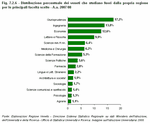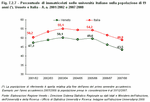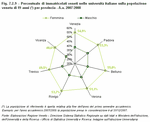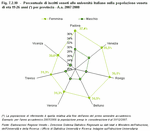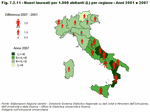7.2 - The appeal of university
|
The Italian university reform, which distinguishes between three-year courses and higher-degree courses, aims to broaden student choice and lower the age at which students finish tertiary education.
Long-term data shows that there is an increasingly broad range of university courses on offer in Veneto. In fact in eight years, the number of university courses has more than tripled and in the 2007/2008 academic year there were more than 500 courses, of which more than half at the University of Padova. Student numbers have also risen. The number of students registering at Veneto universities has increased by 9% since 1999/2000, 1% less however than the total increase in Italy for the same period. Following the university reform, there was a sharp increase in numbers both in Veneto and at a national level. Since 2004/2005, however, the trend has changed direction, which seems to indicate an end to the initial positive effect of the new course model. In 2007/2008 in Veneto, unlike the general situation in Italy, there was another change in the trend, showing students' desire to begin tertiary education in our universities. More than 18,700 students have just registered, up almost 2% on the previous academic year, a figure that accounts for 6.1% of the national total. The most popular faculties are still Economics, Arts and Humanities, and Medicine, the numbers for which have risen by 13.2%, 12.4% and 10.7% respectively. (Figure 7.2.1)
These students make up almost 18% of the 104,800 students in Veneto universities, up 0.7% on numbers for the previous academic year. Once again, in the 2007/2008 academic year, the most popular faculty was Arts and Humanities which accounts for almost 14% of the total number of students. Next comes Economics with 11.6% of the students and then Engineering with 9.7%. Female students accounted for over 59%, whereas in the faculties of Education, Foreign Languages and Literature, and Psychology their share exceeds 80%. Engineering courses are still dominated by males, with 84 out of 100 students. Lower university dropout numbers
A high level of education can increase the innovative capacity of the economy, production and the spread of new knowledge about new technologies, products and processes, thereby promoting the development of a region. It is therefore necessary not only to pay attention to the courses offered in our universities, but also to student attendance. University dropout numbers are on the decrease in Veneto. In the 2007/2008 academic year less than 13% of students dropped out after their first year, compared with over 17% for the previous year and 23% for 2000/2001. These are better figures than the national ones where in 2007/2008 over 17% of students did not register for their second year. This number is, however, lower than previous years. What is more, if the regions Valle D'Aosta and Molise are excluded as they have low enrolments, last year Veneto was the region with the second lowest dropout rate. Lombardia came first with just 11.1%, a greater improvement on 2006/2007 figures than other regions. According to recent figures Venice's Ca' Foscari University has the highest dropout rate for universities in the region, whilst the I.U.A.V. (Venice University Institute of Architecture) has the lowest dropout rate. This is not surprising considering the low number of students at this particular university. (Figure 7.2.2) Veneto university graduates
Taking into account long-term data, the number of graduates from Veneto universities has risen as over the last seven years there has been a 71% increase in the number of students who complete their studies. In 2007 around 20,400 students graduated from Veneto universities, 6.8% of the total number of graduates in Italy. The number was, however, around 900 lower than the previous year and they were mainly graduates of arts and humanities, economics and statistics, medicine and engineering degrees. In 2007 12.7% of students graduated in Arts and Humanities, 12.1% in Economics or Statistics, 11.7% in Medicine and 11.3% in Engineering. Who studies in Veneto?
Where do the students studying at Veneto universities come from? Due to the reorganisation process which has been affecting Italian universities for some years, it is essential to analyse where the students come from. This will help develop suitable, effective planning so that each university can meet the needs of students in terms of services and facilities. In the 2007/2008 academic year, 77.8% of the students at Veneto universities were residents in the region, whether in the same municipality as the university or from other municipalities in Veneto. More than 18% of the students came from outside Veneto and 3.7% were international students. The University of Padova attracts the highest number of international students, taking on over 59% of the immigrants who decide to study in our universities. However, when considering the share of students registered in each university, the University of Verona has the highest proportion of international students (4.4%). (Table 7.2.1) Over recent years, the percentage of students attending Veneto universities who are also resident in Veneto has dropped by 1.5%. On the other hand, the number of students without Italian citizenship has almost tripled in almost six years. The number of residents from other Italian regions has fallen, perhaps because of the higher number of faculties spread around Italy, which means students no longer have to travel far. (Figure 7.2.3) Where do these other Italian students come from? They are mainly students from regions bordering Veneto. In the 2007/2008 academic year they came in particular from Lombardia (over 29%) and Trentino (22%). They mainly choose courses at the University of Verona, given that it is close to these regions, but the University of Padova also hosts a high proportion of these students. However, Veneto universities are not only chosen by students whose families live relatively nearby. There are also those who come from far away. In fact students also come from Puglia (in fifth place) and Sicilia (in sixth place). This mobility is mainly due to a strong interest in degrees in psychology, so much so that almost 9% of students registered on psychology degree courses at the University of Padova are from these two regions. In general, in recent years the most popular faculties for students from other parts of Italy are Psychology, Arts and Humanities, and Foreign Languages, which offer the well-established, attractive courses that partly characterise the mainly humanistic identity of Veneto. Last year 17.6% of first-year students came from other regions, almost 1% less than the previous year. They mainly chose medicine, followed by language and literary degree courses, whilst fewer students chose psychology. International students in Veneto
Following a rise in mobility over recent years, there were almost 3,900 international students in Veneto universities in the 2007/2008 academic year. The percentage of international students in Veneto is higher than the national average (3.7% as opposed to 2.9%).The main nationalities in Veneto universities are Albanian (26.6% of international students), Romanian (8.9%) and Croatian (7.5%). The most popular faculties, unlike choices made by Italian students from other regions, are Medicine, Political Science and Economics. Engineering and Mathematical, Physical and Natural Sciences are in sixth and seventh place. Nine hundred international students registered at Veneto universities in 2007/2008, up 16.6% on the previous year and more than triple the figure for six years earlier. A total of 4.8% of first-year students in Veneto are foreign, 1% higher than the national total, but lower than many other regions. Most of these students are again Albanian (15%) and Romanian (13.8%). The number of Romanians has almost doubled since the previous year following their entry in the European Union. However, the number of Albanians beginning a degree course in Veneto has dropped by almost half. The next largest groups of international students come from China and Cameroon. Their numbers have almost doubled since the previous year, whilst the number of students from Croatia, and Serbia and Montenegro, which in 2006/2007 were in third and fourth place, moved down to sixth and eighth place respectively the following year. (Figure 7.2.4) As with the Italian first-year students who leave their region of origin to come and study in Veneto, the three most popular courses for international students are languages and medicine. These two fields, however, are not the first choice for students from Veneto. Around 16% of international students read in the Faculty of Arts and Humanities, 14% in Economics and almost 13% in Medicine.
The statistics for students who choose a Veneto university for their tertiary education are significant as they not only give a picture of the situation here, but also enable us to evaluate the efficiency, effectiveness and appeal of the courses on offer. However, it is just as important to consider how many Veneto students there are and where they choose to graduate.
As mentioned above, the biggest share of students in Veneto universities are, of course, from Veneto. However out of the 111,300 Veneto students at university, there are many who prefer to go elsewhere. Veneto students inside and outside the region
In the 2007/2008 academic year, out of all the Veneto students registered at university, over 73% were studying in the region, almost 60% of them at the University of Padova. Young Veneto students mainly stay within the region to study literature, economics and engineering. The faculties of Economics and Engineering are, in fact, so attractive to students from Veneto that they make up almost 90% of the total number of students. On the other hand, the Faculty of Psychology is less appealing for young residents in Veneto. They make up less than half the total number of students in this faculty which, however, is highly attractive to students from other regions.The number of first-year students from Veneto who decide to go to their local university is down. Even though in recent years this phenomenon has become less relevant, compared to six years ago the percentage of those beginning a new degree course in Veneto out of the total number of first years from Veneto has dropped by 1.5%. Moreover, the choices for those staying in their region of origin are unchanged, that is they are still choosing the same subject areas. In 2007/2008 25% of first-year students from Veneto chose to study in another region. The most popular destinations are Emilia Romagna and Friuli Venezia Giulia to which 30% and 29% of students who study outside their region go respectively. (Figure 7.2.5) Around 30,000 students from Veneto go to university in another region, that is 26.7% of the total number of university students from Veneto. The faculties which draw students away from Veneto are Law (in 17.2% of the cases), which at the University of Padova is known for being a particularly difficult faculty. Students tend to go to Ferrara and Trento. Students wanting to study engineering mainly go to Friuli Venezia Giulia, but also Trentino Alto Adige or Emilia Romagna and this is chosen by 13.8% of the Veneto students who study outside their region. Economics is chosen by 12.6% of the students, and they go especially to universities in Milan. Given that an increasingly innovative and technological society can compete better with other countries, it is interesting to highlight how Veneto's new human capital is strongly oriented towards the scientific subjects. Many students who remain in Veneto choose sciences, but many others go away for various reasons: to follow a course that does not exist in Veneto; because a certain university is highly acclaimed for certain courses; or because some students first try studying in a faculty near home, but decide to change university rather than type of course if they do not get along there. (Figure 7.2.6) Choices made by Veneto students over recent years
It is interesting to look at the situation of Veneto students and graduates, whether at university in their own region or in other regions, and at changes that have come about over a long period. Over the years, in line with the national situation and in almost all Italian regions, the number of Veneto school-leavers who decide to go into further education is in decline. In fact compared to six years ago, the 2007/2008 academic year saw a drop of almost 4% in the share of first-year students from Veneto out of the total population of 19-year-olds. The average for Italy, on the other hand, has dropped by 2%. As mentioned earlier, for registrations in Veneto universities, and for registrations of Veneto students, whether at university in Veneto or in other regions, a noteworthy increase can be seen in the early years of the university reform, so much so that in 2003/2004 over half of 19-year-olds continued with their studies, whilst in more recent years this tendency seems to be trailing off. This is the case with both male and female students, but more so with males. In fact in 2007/2008 52% of 19-year-old girls from Veneto began university, over 2% less than in 2001/2002, whilst for boys the figure was 36%, almost 5% lower than six years earlier. Last year the Veneto province with the highest number of students investing in higher education and guaranteeing themselves a better future was Venezia (46.3% of 19-year-olds), while the province with the least inclination for university was Vicenza (40.5%). Considering, then, the total number of Veneto students registered out of the relative population aged 19-26 years, up until last year there was an increasing number of students in tertiary education, an effect of the abovementioned increase in higher enrolments at university in the early years of the reform. Last year, however, there was a change in direction and the share went down by 0.4% on the previous year. The same trend can be seen for the national average, where however there are higher numbers than those for Veneto every year. (Figure 7.2.7) and (Figure 7.2.8) In the 2007/2008 academic year, Padova was the province with the highest percentage of students between 19 and 26 years (33.2%), while Vicenza was the province with the lowest percentage in tertiary education (26.3%). In all the provinces, there is by far a higher share of girls than boys, with the gap between the sexes being biggest in Rovigo. This may be because in a region like Veneto, for years known for the ease with which one can enter the job market compared to other regions, many boys still want to begin work early, enticed by their first earnings. (Figure 7.2.9) and (Figure 7.2.10) Graduates: the driving force
In general, between 2001 and 2007 an increase in the level of higher education can be noted in all the regions in Italy. In the last year for which data is available, in Italy there were about 5 new graduates per 1000 residents, two more than at the beginning of the millennium. At the top of the list for the number of students per 1000 residents that graduated in 2007 are the regions of the Centre and South. It is harder to find a job in these areas and so it has become necessary to focus on obtaining a university degree, in the knowledge that higher levels of education often correspond to lower risk of social disadvantage. Molise is the top region with over 7 new graduates in 2007 and the highest level of improvement in education in the last six years. In fact compared to 2001, the figure has almost doubled. Veneto is mid-list with a figure equal to 4.5, a point and a half higher than the figure recorded in 2001, and higher than the figure for its regional competitors (Toscana and Lombardia 4.3, Emilia Romagna 4.1 and Piemonte 4). (Figure 7.2.11)In 2007, there were roughly 21,600 new graduates in Veneto, about 59% more than six years earlier and equal to more than 7% of the national total. Considering its higher university numbers, for some years the province with the best performance has been Padova, which accounts for over 5 new graduates per 1000 residents, while Vicenza is the province with the lowest share (4.1). In general, for some years, Veneto's high-level human capital has left university for the most part after studying in the fields of economics and statistics, or engineering: 14.8% and 13.4% respectively of all new graduates were trained in these fields in 2007. These figures are fundamental, as reflected in Europe's strategies, if we are to live better in our more technological, innovative and complex society; so to participate in European development, it is necessary to focus on a solid grounding in scientific and technological studies, and so to push for an increase in graduates in these disciplines. |
|
Data processed by the Statistics Office of Regione Veneto are collective property; reproduction of this material is authorised for non-commercial purposes only, provided the source "Regione Veneto - Regional Statistics System Management" is acknowledged.
English translation by the University of Padova Language Centre.




